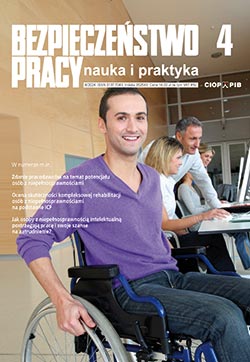Shift work – health effects and their reduction
Patrycja Łach, Joanna Mazur-Różycka, Danuta Roman-Liu
The article deals with the issue of changes occurring in the human body as a result of performing professional duties at non-standard hours in shift work both day at night. It was described how sleep deficits and resulting disorders can affect physiological processes and intensify unhealthy habits and behavior of employees. A number of activities were also presented, the implementation of which allows for mitigating the negative effects of shift work and maintaining good quality of sleep.
Legal framework of the safety and health at work at the sea-going merchant vessels
Maciej Kijowski
The article commemorates the 40th anniversary of issue and entry into force of the ordinance of the Minister of Foreign Trade and Shipping on safety and hygiene of work at the sea-going merchant vessels of June 25, 1979. This act, yet to be ever amended, is an example of the complete and competent legislation, as well as arouses appreciation by its illustrious embrace of legal, technical and organizational sides of safety and hygiene of work at a sea-going vessel. Abstracting from the law on work at sea of August 5, 2015, the author discusses also the competences of a shipmaster in the sphere of occupational safety that are present in other sources of universally binding law.
New technology in the development of personal equipment protecting head
Marcin Jachowicz
Very often while working or playing sports a person is exposed to a many hazards. One of the most dangerous threats is head injuries. We are not able to eliminate them completely. To minimize them, various types of head protection are used. Their design and construction are constantly changing and evolving, and the protective parameters are closely matched to the anticipated threats. New materials and technical solutions are used in the construction of helmets, which are aimed at increasing human safety and comfort of use, as well as reducing weight and increasing its functionality. Such goals can be achieved mainly thanks to the use of modern design software and simulation of behavior e.g. during shock absorption or by using shock absorbing materials with specially selected damping characteristics.
This article contains information on modern design methods and computer simulation of the behavior of developed models of protective helmets during shock absorption. Shock absorbing materials with specially selected strength-deformation characteristics were also presented. These materials also provide high protective and functional properties.
Evaluation of tonal noise in work environment
Jan Radosz
Noise as a stressor may contribute to the development of various types of illnesses, cause distraction, hinder work and reduce employee’s productivity. The elements of the technical equipment of the building as well as office equipment can emit perceptible tonal sounds. The widespread presence of these devices in the work environment potentially translates into several hundred thousand jobs in Poland that may relate to this issue. Numerous literature reports indicate that the annoyance of the tonal noise assessed subjectively is greater than that of the broadband noise. In the assessment of the working environment, there are no criteria regarding the tonal noise either in the rooms (building standards) or in the field of noise at workplaces (assessment in terms of annoyance). The article reviews existing legislation, analyses literature data and provides the results of surveys regarding the tonal noise annoyance carried out in CIOP-PIB.




























